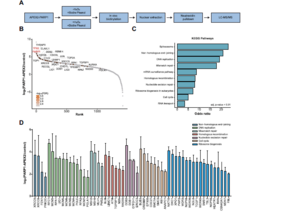The SFB projects from Petra Beli, Vassilis Roukos and Katja Luck have published a joned paper on "PARP1 proximity proteomics reveals interaction partners at stressed replication forks"
10-11-2022
PARP1 mediates poly-ADP-ribosylation of proteins on chromatin in response to different types of DNA lesions. PARP inhibitors are used for the treatment of BRCA1/2-deficient breast, ovarian, and prostate cancer. Loss of DNA replication fork protection is proposed as one mechanism that contributes to the vulnerability of BRCA1/2-deficient cells to PARP inhibitors. However, the mechanisms that regulate PARP1 activity at stressed replication forks remain poorly understood. Here, we performed proximity proteomics of PARP1 and isolation of proteins on stressed replication forks to map putative PARP1 regulators. We identified TPX2 as a direct PARP1-binding protein that regulates the auto-ADP-ribosylation activity of PARP1. TPX2 interacts with DNA damage response proteins and promotes homology-directed repair of DNA double-strand breaks. Moreover, TPX2 mRNA levels are increased in BRCA1/2-mutated breast and prostate cancers, and high TPX2 expression levels correlate with the sensitivity of cancer cells to PARP-trapping inhibitors. We propose that TPX2 confers a mitosis-independent function in the cellular response to replication stress by interacting with PARP1. To read further click here.
Mosler T, Baymaz HI, Gräf JF, Mikicic I, Blattner G, Bartlett E, Ostermaier M, Piccinno R, Yang J, Voigt A, Gatti M, Pellegrino S , Altmeyer M, Luck K, Ahel I, Roukos V , Beli P (2022) PARP1 proximity reveals interaction partners at stressedreplication forks. Nucleic Acids Research, doi: https://doi.org/10.1093/nar/gkac948

